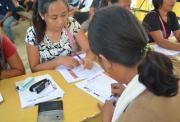Although Typhoon Hagupit – known as Ruby in the Philippines – is reported to have taken only a handful of lives, for thousands of people in the country, it was still a sort of repeat of Typhoon Haiyan, which had torn through the Philippines in November 2013, leaving more than 7,000 dead or missing. “It’s déjà vu, but not the same as last year with Haiyan,” a Tacloban resident Mariano Tan Jr told the BBC.
Hagupit had initially been feared to be as severe as Haiyan, which was the most powerful typhoon ever recorded over land. However it was downgraded a day before it hit land and continued to weaken as it moved across the Philippines. It remains though the strongest storm to hit the Philippines this year.
This time, there were widespread preparations before the typhoon hit land. Joey Salceda, governor of Albay province where Legazpi is situated, told the BBC that the main lesson from Typhoon Haiyan had been to prepare well and to evacuate people from vulnerable areas. About a million people are said to have been evacuated in what some have called the largest peacetime evacuations in Philippine history.
However, although the casualties were much less this time, Hagupit still left considerable damage in its wake. In Tacloban, where thousands were killed by typhoon Haiyan last year, roofs were blown away and streets were flooded.
“The devastation in homes is huge because of the strong winds,” the BBC reported Philippine Interior Secretary Manuel Roxas having told local radio DzBB. “Many people voluntarily returned to evacuate centres tonight (December 7) … because they do not have homes anymore.”
In Northern Iloilo – one of the areas most severely affected by Haiyan – Simbahang Lingkod ng Bayan (SLB), the social justice arm of the Philippine Jesuits, has reported that although people in Carles were able to go home, in Estancia, the situation is worse. More than 2,400 families had to flee their homes, and on December 9, about 200 families were still in evacuation centres. There are two reported casualties, and several houses made of light materials suffered severe damage. Farms also sustained considerable damage, crops were destroyed, and there is a shortage of food.
The people in Iloilo probably do feel a sense of déjà vu, and they know only too well that surviving a typhoon’s destructive winds is only the first step. They faced months of recovery when they left the evacuation centres after Haiyan. Many of their homes had been made of plywood or bamboo, and had been destroyed by the super typhoon.
Jeanie Olvido, a municipal councillor from Estancia, Iloilo, remembered those days after Haiyan: “Sobra pa sa nasunugan ([Haiyan’s aftermath] was worse than a fire’s).”

When Hagupit swept through earlier this month, the people of Northern Iloilo were getting back on their feet. Non-governmental organizations, including SLB, had helped them recover in the aftermath and are continuing to help in their rehabilitation.
In partnership with Habitat for Humanity Philippines (HFHP), SLB had provided 600 residents in Estancia and Carles, Northern Iloilo with shelter repair kits last November. The SLB-HFHP project is an act of empowerment, with local volunteers helping SLB and HFHP with research, residents collecting building materials themselves, and building supplies coming from a local hardware store. Lovella Dorero, HFHP disaster risk reduction and management program manager, said this helps the beneficiaries understand that they are part of the housing rehabilitation process. “Hindi rin lahat maibibigay ng iba, (We can’t depend on others for everything),” she said.
Some of the families helped by the SLB-HFHP project had already repaired their houses before Typhoon Hagupit. However, although their newly repaired houses sustained some damage from Hagupit, the extra roofing materials provided in the shelter repair kits had helped to make their houses more resilient. The families who had not yet used their shelter repair kits can now use the materials to repair the damage from both typhoons.
As the people of Estancia and Carles work on rebuilding their homes, they hope too that they may regain their livelihood as fisher folk and farmers, they hope that their children can one day return to school after putting off their studies in favour of shelter and food for their families. They continue to hope. [SLB, BBC]

